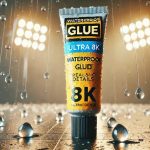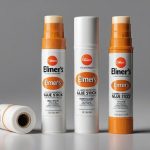Yes, concrete can stick to glass, though it’s not as straightforward as it might seem. These two materials, with their vastly different properties, pose a unique challenge when it comes to bonding. Concrete, made from cement, water, aggregates, and additives, contrasts sharply with glass, which is primarily composed of silica. Yet, through a combination of surface treatments and chemical interactions, a strong bond can indeed be achieved.
Key Takeaways:
- Surface Properties and Chemical Composition: Concrete and glass have distinct properties that typically resist bonding, but specific techniques can enhance adhesion.
- Surface Preparation: Treating glass with acid or sandblasting can create a rough texture, providing better footholds for concrete.
- Chemical Bonding: Microscopic imperfections on the glass surface allow concrete to form a chemical bond.
- Alkaline Silica Reaction (ASR): Over time, this reaction can reinforce the bond between concrete and glass.
- Specialized Adhesives: Products designed specifically for this purpose can significantly improve the bond strength.
- Challenges: Factors like the porous nature of concrete and potential chemical reactions need careful consideration for successful adhesion.
Understanding the intricate process of bonding concrete to glass opens up innovative possibilities in construction and design, allowing for creative and durable architectural solutions.
Table of Contents
- 1 What is Concrete Composed Of?
- 2 What is Glass Made Of?
- 3 Why Does Concrete Not Stick to Glass?
- 4 Specialized Adhesives for Bonding Concrete to Non-Porous Materials
- 5 Modifying the Surface of the Glass to Enhance Compatibility with Concrete
- 6 Potential Challenges in Achieving a Perfect Bond between Concrete and Glass
- 7 Conclusion
What is Concrete Composed Of?
The main components of concrete that allow it to adhere to glass are the chemical properties of both materials and the use of specialized adhesives.
Concrete contains cement, water, aggregates, and additives, while glass is composed mainly of silica. The surface properties and chemical composition of both materials play a crucial role in their ability to bond.
Techniques like acid exposure or sandblasting can be used to create rough textures on the glass surface, increasing surface area for chemical interaction with concrete. Additionally, the process of alkali-silica reaction (ASR) between concrete and glass helps to further reinforce their bond over time.
Specialized adhesives are also available for bonding concrete to non-porous materials like glass.
What is Glass Made Of?
Glass is a remarkable material with unique properties such as transparency, durability, and versatility. The main components that make up glass are silica, soda ash, and limestone, each playing a critical role in its structure and characteristics. Here’s a detailed breakdown:
| Component | Description | Contribution to Glass Properties |
| Silica (SiO2) | Silica, also known as silicon dioxide, is the primary ingredient in glass, usually derived from sand. | Provides the fundamental network structure for glass, contributing to its hardness and chemical resistance. |
| Soda Ash (Na2CO3) | Soda ash, or sodium carbonate, lowers the melting point of silica. | Makes the glass formation process more energy-efficient and helps in reducing the viscosity of molten glass. |
| Limestone (CaCO3) | Limestone, or calcium carbonate, is added to stabilise the silica-soda mixture. | Enhances the durability and chemical resistance of glass, making it less prone to weathering. |
| Alumina (Al2O3) | Alumina is often included in small amounts. | Increases the glass’s viscosity and improves its resistance to thermal and mechanical stress. |
| Boron (B2O3) | Boron oxide is sometimes added to glass. | Enhances thermal resistance and decreases the coefficient of thermal expansion, making glass suitable for laboratory equipment and cookware. |
| Magnesium (MgO) | Magnesium oxide is another additive found in some glass compositions. | Improves the glass’s stability and increases its resistance to devitrification (crystallisation). |
| Titanium Dioxide (TiO2) | Titanium dioxide can be added for specific properties. | Enhances the refractive index and UV resistance of glass, useful in optical and architectural applications. |
Why Does Concrete Not Stick to Glass?
The non-stick nature of concrete and glass is due to their distinct compositions and surface properties. Concrete, primarily composed of cement, water, aggregates, and various admixtures, forms a paste that binds to surfaces through chemical reactions and physical interlocking. However, glass, composed mainly of silica along with soda ash and limestone, has a smooth, non-porous surface that lacks the microscopic texture needed for concrete adhesion.
Here’s a closer look at how their compositions contribute to this non-adhesive relationship:
| Material | Key Components | Surface Characteristics |
| Concrete | Cement, Water, Aggregates, Admixtures | Porous, rough, and alkaline |
| Glass | Silica, Soda Ash, Limestone | Non-porous, smooth, chemically inert |
Specialized Adhesives for Bonding Concrete to Non-Porous Materials

There are several types of specialized adhesives available for bonding concrete to non-porous materials such as glass. These adhesives have been developed specifically to overcome the challenges of bonding these two materials together.
- Epoxy resins: Epoxy resins are a popular choice for bonding concrete to glass due to their high bond strength and excellent adhesion properties. They can also be used as a primer to create a strong bond between the two materials. However, proper surface preparation is crucial when using epoxy resins, as any contaminants or moisture can affect the bond quality.
- Polyurethane adhesives: Polyurethane adhesives are another commonly used adhesive for bonding concrete to glass. They have high bond strengths and can withstand extreme temperatures, making them suitable for outdoor applications. These adhesives also have good chemical resistance, making them suitable for bonding glass to concrete in harsh environments.
- Silicone sealants: Silicone sealants are often used in construction for their flexibility and weather resistance. They can also be used as an adhesive for bonding concrete to glass, providing a strong and durable bond. However, silicone sealants may not be suitable for all types of glass, so it is essential to test compatibility before use.
- Hybrid adhesives: Hybrid adhesives combine the benefits of both epoxy and polyurethane adhesives, providing a strong bond and excellent flexibility. They are also resistant to chemicals and temperature fluctuations, making them ideal for bonding concrete to glass in various applications.
In addition to these specialized adhesives, proper surface preparation is crucial for achieving a strong bond between concrete and glass. This can include techniques such as acid exposure or sandblasting to create a rougher surface on the glass for better adhesion.
In conclusion, there are various types of specialized adhesives available for bonding concrete to non-porous materials like glass. Each type has its unique properties and advantages, and the choice of adhesive will depend on the specific application and compatibility with the materials.
Modifying the Surface of the Glass to Enhance Compatibility with Concrete
Modifying the surface of glass is a key factor in enhancing its compatibility with concrete and increasing its adhesion. The surface of glass can be modified through a variety of methods, including chemical treatments, coatings, and mechanical roughening.
One approach to modifying the surface of glass is through chemical treatments, which can alter the chemical composition of the glass surface to improve its compatibility with concrete. This can involve using acids or alkalis to etch the surface, creating a more reactive surface for stronger bonding with concrete. However, this method may require specialized equipment and should be carefully monitored to prevent over-etching or damage to the glass.
Another method is through coatings, which involve applying a layer of material onto the surface of the glass. These coatings can act as a barrier between the glass and concrete, preventing any potential reactions or chemical incompatibilities. They can also provide a rougher surface for increased adhesion. Examples of coatings that have been used successfully for bonding glass and concrete include epoxy resins and polyurethane sealants.
Mechanical roughening is another effective way to modify the surface of glass. This involves creating physical abrasions on the surface through sandblasting or grinding, which can create a rougher surface for better adhesion with concrete. However, this method can be time-consuming and may require specialized equipment.
Potential Challenges in Achieving a Perfect Bond between Concrete and Glass
Achieving a perfect bond between concrete and glass is fraught with challenges due to several factors. Below are the common obstacles that can hinder effective bonding:
| Thermal Expansion Mismatch | Concrete and glass have different rates of thermal expansion. When subjected to temperature changes, they expand and contract at different rates, leading to stresses that can weaken or break the bond. | Concrete typically expands more than glass under heat, causing potential cracks and bond failure over time. |
| Surface Properties | Glass is inherently smooth and non-porous, making it difficult for concrete to adhere without proper surface treatment. | To enhance adhesion, the glass surface needs thorough cleaning, roughening, or the application of primers. |
| Chemical Composition | The chemical nature of glass and concrete can inhibit bonding. Glass is largely inert, while concrete is highly alkaline, which can lead to chemical incompatibility. | Using specialized adhesives designed for both materials can mitigate these issues, but they are not foolproof. |
| Surface Preparation | Improper surface preparation can significantly weaken the bond. This includes inadequate cleaning, failure to roughen the glass surface, and not using appropriate primers. | Ensuring meticulous preparation can improve the bonding potential, but it requires precision and care. |
| Moisture Sensitivity | Adhesives and primers used to bond concrete and glass can be adversely affected by moisture. | Moisture can infiltrate the bond, causing degradation and reducing adhesion strength over time. |
| Mechanical Fasteners | While mechanical fasteners like anchor bolts and glass clamps can provide a reliable alternative, they also introduce potential points of weakness. | These methods can be quick and effective but may not be suitable for all applications, especially where aesthetic considerations are paramount. |
| Joint Design | Poor joint design can lead to stress concentrations and movement that exceed the bond’s strength. | Effective joint design and proper surface preparation are crucial for maintaining a strong bond. |
Conclusion
Concrete sticking to glass might seem like a surprising combination, but it’s indeed possible with the right techniques. Despite their differing properties, these materials can form a robust bond through careful surface preparation and the use of specialized adhesives.
Surface preparation is key. Techniques like acid etching or sandblasting roughen the smooth glass surface, creating micro-textures that concrete can grip. This physical interlocking is further reinforced by chemical interactions at a microscopic level. Additionally, the alkaline silica reaction (ASR) between concrete and glass over time can strengthen the bond.
Specialized adhesives, such as epoxy resins, polyurethane adhesives, and silicone sealants, play a crucial role. These adhesives are designed to bridge the gap between the porous nature of concrete and the smooth, non-porous surface of glass, ensuring a strong, durable connection.
However, challenges such as thermal expansion mismatches and moisture sensitivity must be managed. Proper surface treatment, choosing the right adhesive, and meticulous application are essential to achieving a successful bond.
In essence, bonding concrete to glass opens new avenues in construction and design, allowing for innovative and durable architectural solutions.






